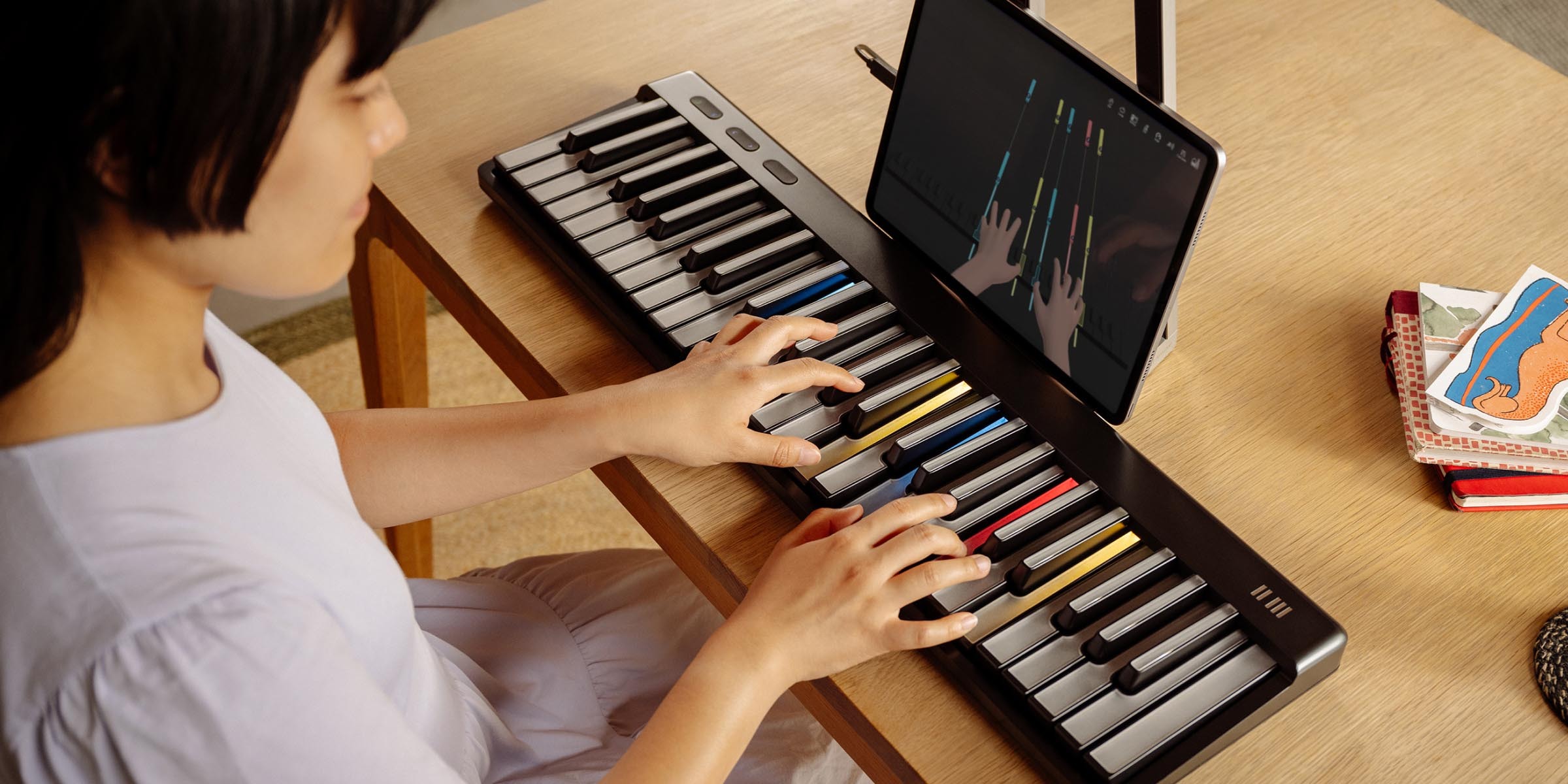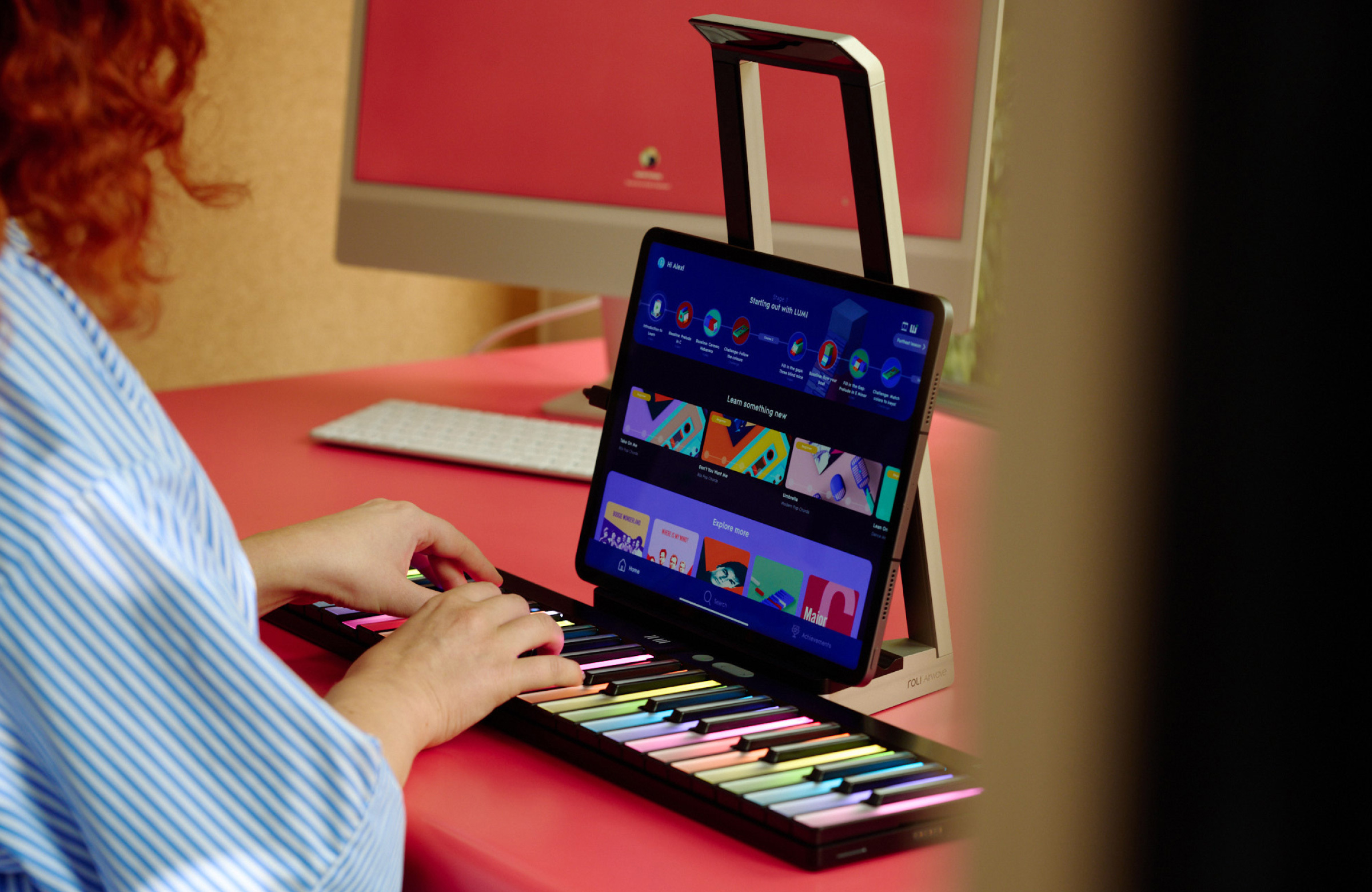How long will it take to learn piano?
How long does it take to play a song? To really get good? To master the instrument? All your questions answered.
How long will it take to learn piano?
Learning the basics of piano playing can take a few months to several years, depending on how often you practice and how ambitious your goals are. However, if your piano-playing ambitions are a little more modest, then you can make great progress in a much shorter timeframe.
Perhaps the most common question we get from aspiring music makers is simply,“How long does it take to learn the piano?”
Unfortunately, this question is a little like “how long is a piece of string?” (Though if it happens to be a piano string, the answer is somewhere between a couple of inches and around eight feet.)
So, in order to answer this seemingly simple question, it’s important to establish right away that there’s no correspondingly simple answer. We can, however, shed a little bit of light on the situation by considering what we mean by “learn”.
Do you have a favourite song in mind you’d like to play for your own enjoyment? Do you dream of performing for your family and friends? Are you hoping to pass an exam? To recite classic works on stage? To conquer the world of classical piano and change the face of music as we know it?
Below, we’ve laid out a rough timeline of what you might expect at various stages of your piano-learning journey. The key thing to remember, though, is that it’s your journey, and it won’t look quite like anyone else’s. Just as there’s no one path to progress, there’s no one speed you’re meant to learn at. What matters is that you’re having fun, learning at a pace that’s right for you, and progressing towards your own personal learning goals.
A few minutes
Let’s start with the good news: if your goal is simply to play along with your favourite song, you may already be much closer than you think. Even if you’ve set your sights on something a little more lofty in the long term, this is a great place to start.
Have you ever played rhythm-based video games like Guitar Hero or Rock Band? If so, you’ll be familiar with the basic mechanics of notes cascading down your screen — hit the right button at the right time to score more points. That’s how the ROLI Piano System works, with the added bonus that the keys themselves will light up when it’s time to play them.
We believe that learning to play begins with playing to learn, so — in a very real sense — it simply takes the length of your favourite song to learn to play it. Are you going to get it exactly right on your first go? Probably not, but that’s okay; we make some of our best progress when we practice by ourselves and repeat the things we’ve already learned. So have another go, watch your scores improve, and do it again. Before long, you’ll have the most important notes committed to memory and find that playing along becomes easier and easier.
Does that mean you can “play” the piano? We’d say so.

A few weeks
Okay, so you’re looking to go a little deeper — to learn a bit more about the theory and the technique behind the parts you’re playing. That’s admirable, and adding some context around your playing is going to help you practice more effectively, meaning you progress faster and further.
Alongside playing to learn, then, it’s time to add in some good old-fashioned learning. And whether it’s video lessons in the ROLI Learn app, hitting the books by yourself, or enlisting the help of a piano teacher, the main thing here is to find yourself a method that works for you. Plenty of people have successfully learned to play the piano already. So instead of trying to figure everything out from scratch, follow in their footsteps and find yourself a structured programme that’s designed to take you where you want to go with the instrument.
The first steps of any good piano-learning programme are all about giving you the basic building blocks you’ll need later on. The first lessons may seem simple, but you’ll be calling upon the things you learn now whenever you sit down to play, practice, or perform in future. With ROLI Learn, Stage 1 is dedicated to playing simple basslines in order to build your co-ordination and get acquainted with the app’s system of colour-matching notes.
From there, Stage 2 introduces new musical patterns, talks more about correct fingering, and begins teaching chords. This is also where you’ll begin your journey of learning to read musical notation (if you don’t already).
There’s no right speed to learn at, and you can make great progress with just a few minutes per day. With real dedication and repeated practice, however, you could find yourself deep into Stage 2 within just a few short weeks, giving you a decent grasp of all the above. You’ll also have had time to begin building a repertoire of hit songs from the 1,000+ available in the library.
By this point, we think it’s safe to say you play the piano.
A few months
But what if we want to be good at the piano? Again, it’s hard to say where the line is — at what point does someone really become good at anything?
What we can say for sure is that becoming proficient at playing any instrument requires sticking with it for a period of time. Many newcomers to ROLI Learn have previously attempted to pick up the piano via more traditional methods that simply didn’t stick, perhaps due to time constraints or because they weren’t so motivated to learn at the time.
If you are motivated however, and have plenty of time to dedicate to lessons (virtually, or in real life), learning songs, and practicing effectively (don’t worry, we’ll teach you how), it’s very possible to have a very solid grasp of the instrument’s basics within a few months.
Bear in mind, however, that this represents quite an intense approach. We generally recommend that short, but frequent, sessions are the best way for most people to learn. Learning for just a few minutes every day tends to result in more consistent motivation over the long term than pushing ourselves to do longer, more intensive sessions. If we want to answer the question of how long it takes to learn piano, however, it’s interesting to consider the latter approach.
Using the ROLI Learn curriculum as a guide again, “completing” the full course involves finishing more than 200 video lessons and nearly 50 associated challenges. There’s also a series of 24 song-based mini courses that we’d recommend to all learners, plus additional challenges, musical games, and of course the song library. Getting through all of this is a serious time investment, especially when you consider that you’ll need to make time to practice what you’ve learned. We also recommend repeating sessions any time you’re unsure of a technique, come across something particularly, or just need a refresher.
That said, if you really get stuck into learning with the app — and make plenty of time to practice — it would take just a few short months to gain a good understanding of pitch and rhythm, note durations, sharps and flats, key signatures, chords, and more. What’s more, you’ll have “learned how to learn” making your practice sessions and playing time more productive as a result. And if you’re using two Piano Ms or a full-size ROLI Piano, you’ll also have learned a great deal about playing with two hands at once.
And if you’ve put a similar amount of effort into learning new songs, you’ll have developed an impressive repertoire alongside the skills to perform it. Next time you come across a piano at a party, not only will you have the ability to play for your friends, you’ll be able to take requests too.
At this point, it should be clear to everyone that, yes — you can play the piano.

A few years
This, we suspect, is the answer that applies to most people. If we take “learning” to mean something like the above — a good grasp of all the skills and knowledge we need to learn new songs, enjoy playing for ourselves and others, and perhaps to begin writing music of our own — “a few years” is a good rule of thumb. If the previous section was the “speed-running” approach, this is the slow and steady alternative we’d actually recommend.
Following the little-and-often approach with ROLI Learn, you’d work your way through the lessons, practicing in between and repeating as often as you need to feel confident in what you’ve learned. You’d pick out your favourite songs from the library, learning them, practicing, and revisiting to try to beat your high scores. You’d do the same thing with the challenges in each stage and complete the song-based mini courses for some valuable experience playing genres of music you might not normally explore. And, perhaps most importantly, you’d play in between times, solidifying concepts from the lessons and committing new techniques to muscle memory.
You’re unlikely to be able to pinpoint a precise moment at which you’ve finally learned piano, but you will look back at some point and realise you’ve been playing all along.
A lifetime
The question, seemingly then, has been answered. Given enough time and motivation, it takes between a few minutes and a few years to learn piano, depending on your definition of “learn”. But, as any serious musician will tell you, the learning doesn’t stop there.
Modern technology can make learning an instrument feel like playing a video game, but unlike video games, you don’t “complete” an instrument. Even the best players in the world encounter (or develop) new techniques, new styles, and new approaches to their instruments from time to time. And the very best actively seek out these challenges while perfecting the skills they already possess.
Even if you reach a point you’re happy with and stop formally learning with lessons, apps or books, playing is learning. The only way to stop learning is to stop playing, and why would you want to do that?
Speeding up the process of learning
Looking to learn a little faster? Our latest innovation, Airwave, is designed to make the piano-learning process easier, more efficient, and more fun. It tracks your hands in incredible detail, allowing the ROLI Learn app to provide accurate, real-time feedback on your technique. It’s like having a personal coach available 24/7 to help you make the most of your practice sessions.
Add Airwave to your existing ROLI setup, or preorder it as part of a bundle with Piano M or the new ROLI Piano.
Join the ROLI community